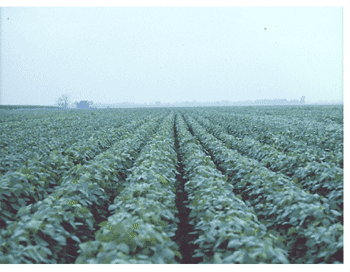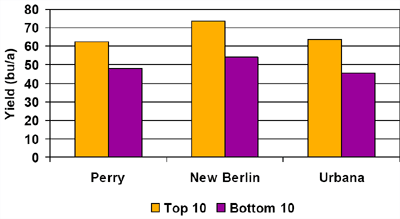The Soybean Checkoff Wants To Give Back $$$ That SCN Is Taking Away
 |
Terry L. NiblackProfessor of NematologyPhone: (217) 244-5940 E-mail: tniblack@illinois.edu |
||
You're an excellent soybean producer. Besides all the other things you do, you know you have soybean cyst nematode (SCN), so you sample your fields periodically to check the numbers. You use SCN-resistant varieties, and you're careful not to grow the same resistant variety in the same field twice in the rotation. In other words, you've really listened to the information on SCN and put it into practice. So why the heck were your plants covered with cysts this summer?! And more importantly, why were your yields down 20 percent?
The number of times this scenario played out in the past few years is alarming and disheartening. Some producers report that they are "giving up" on soybeans. Your checkoff board, the Illinois Soybean Program Operating Board (http://www.ilsoy.org/), put these questions to nematologists in Illinois: What more can we do, other than grow corn every year? How can we make sure that every soybean producer in Illinois gets a return on his/her investment in SCN research?
Our answer, based on checkoff-supported research, shows that there is something simple you can do: "Match" your SCN population to the resistance you use. In 2002, matching made a difference of $8.00 to $24.00 per acre in tests in SCN-infested fields. Matching is a two-step process because you have two organisms to deal with:
-
Determine your Illinois SCN Type.
-
Determine the level of resistance in your resistant variety.
Determine your Illinois SCN Type
SCN has a remarkable ability to adapt to resistant varieties. Once SCN has adapted to a particular variety, whether it is labeled "resistant" or not, the nematode will reduce its yield. Sometimes it takes years for this adaptation to occur, and sometimes it can occur in the space of one growing season. Either way, this is why we recommend that producers change resistant varieties each time they grow soybeans.
How can you tell if your SCN population has adapted to resistance? We have a test that will tell producers what kind of SCN they have so they can match them up with the right SCN-resistant varieties. This is not a race test or an HG Type test, but is based on them. It's called the Illinois SCN Type test because it has been optimized for Illinois soybean producers.
Here's how it works. We extract the SCN from a soil sample and grow the nematodes on four soybean lines in a greenhouse for 30 days, at which time we count the females (cysts) on the roots. From the counts, we calculate a simple percentage called the Female Index (FI = [average number of cysts on test soybean line] divided by [average number of cysts on susceptible soybean] x 100).
The FI indicates which lines SCN will attack. FI numbers are usually less than 100. Anything less than 30 is considered low, and more than 60 is high.
The four lines used for the SCN Type test are a standard susceptible variety (Williams 82) and three lines called plant introductions (PI 548402, PI 88788, and PI 437654). We use these three because 99 percent of the SCN-resistant soybean varieties available in Illinois got their resistance from one or more of these three. They are often called the "sources of resistance."
Using the FI numbers to choose varieties is easy. Choose varieties that have a source of resistance that matches the lowest FI numbers, and avoid varieties that have sources of resistance that match the highest FI numbers (see examples 1 and 2). A variety's source of resistance is easy to find on the Internet or in print (see the next section).
Example 1. The SCN in this farmer's field show a high FI on PI 88788. He can expect varieties with PI 548402 and PI 437654 to have much more effective resistance in his fields. He can use a variety with either PI as a source of resistance this year, then switch to the other source next time he grows soybeans.
| SOURCE OF RESISTANCE | FI | CHOOSE VARIETIES WITH THIS SOURCE OF RESISTANCE |
|---|---|---|
PI548402 |
16 |
Yes |
PI 88788 |
85 |
Yes |
PI 437654 |
4 |
Yes |
Example 2. The SCN in this farmer's field have low FI on all three sources of resistance. She's in luck, and any resistant variety should do better for her than a susceptible one will. She should still switch varieties next time she grows soybeans in this field.
| SOURCE OF RESISTANCE | FI | CHOOSE VARIETIES WITH THIS SOURCE OF RESISTANCE |
|---|---|---|
PI548402 |
12 |
Yes |
PI 88788 |
21 |
Yes |
PI 437654 |
2 |
Yes |
An Illinois SCN Type Test is not necessary every time soybeans are grown. In fact, it probably needs to be done only once. Choose a variety with the source of resistance that matches the lowest FI number, and then the next time soybeans are planted in that same field, choose a variety with a different source of resistance. In this way, SCN will be less likely to adapt to the resistant varieties.
There are two cautions to using the Illinois SCN Type test to design an SCN-management plan.
-
If SCN numbers are very high (say, more than 10,000 eggs per 250 cm3 soil), then even SCN-resistant varieties may be damaged. Always base use of the Illinois SCN Type test on knowledge of the SCN numbers in a field.
-
Base the choice of varieties on yield (of course!). Once the best source of resistance is identified, check out the soybean variety trial data (see next section) and pick the highest-yielding variety that has the desired source of resistance.
Determine the level of resistance in your resistant variety
True or false: All soybean varieties labeled "SCN-resistant" have the same high levels of resistance.
If you answered "true," then you are losing a lot of money. Check out Figure 2 (page 17), which compares the top 10 and bottom 10 highly resistant varieties in maturity group 3 in region 3 of the 2003 Soybean Variety Trials (http://vt.cropsci.illinois.edu/soybean.html).
With support from the Illinois Soybean Program Operating Board, we screen all of the varieties labeled "SCN resistant" that are entered in the Soybean Variety Trials. Some companies will not allow us to perform this screening or publish the results, but the vast majority do.
This project is a collaborative effort among the University of Illinois (myself and the team that conducts the Soybean Variety Trials), USDA (Dr. Greg Noel, also located at the U of I), and Southern Illinois University (Dr. Jason Bond). Varieties are screened for resistance to at least three different "race 3" SCN populations, and to one "race 1" and one "race 5." These represent the most common races that occur in Illinois.
The method used for screening is very similar to that described above for the Illinois SCN Type Tests, but we convert the FI values into resistance ratings (Table 1) for ease of interpretation. Notice that any variety with a FI value of less than 60 is considered to have some level of resistance.
The results of the screening tests for 2003 are available in the Variety Information Program for Soybeans (VIPS) booklet, the VIPS Website (through Stratsoy at http://www.stratsoy.uiuc.edu/), or individually through me (tniblack@illinois.edu). Information is available on 438 SCN-resistant varieties. in the Variety Information Program for Soybeans (VIPS) booklet, the VIPS Website (through Stratsoy at http://www.stratsoy.uiuc.edu/), or individually through me (tniblack@illinois.edu). Information is available on 438 SCN-resistant varieties.
The best way to choose varieties based on this information is, again, to start with yield. Check the yields of varieties (all of the variety test sites are infested with SCN), and choose a list of those that look the best in environments similar to the one where they will be grown. From that list, check the resistance levels from our screening test, and choose the ones with the best resistance (HR, R, or MR) that matches your SCN Type.
Summary
The truth of the matter is that SCN is not an unbeatable pest. But it's also not a simple pest. You can't just spray and pray. You have to remember these few, but important, rules for beating SCN:
-
Check the numbers. SCN sampling is not expensive or difficult. When you sample for fertility, put some of the soil in a plastic bag and ask for an SCN egg count. Keep records for each field, just as you would for any other important cultural factor.
-
Rotate with corn. Corn won't get rid of SCN—most of the nematodes remain dormant until you plant beans again—but corn will reduce the numbers.
-
Rotate with high-yielding SCN-resistant varieties. The old "yield drag" business is no longer a problem in most areas, so don't use that as an excuse to avoid resistant varieties.
-
Rotate SCN-resistant varieties. In other words, don't grow the same resistant variety twice in the rotation. Keep the nematodes confused!
And if you want to maximize soybean productivity in SCN-infested fields, you can match your SCN population to your soybean resistance with an Illinois SCN Type test and information from VIPS. In one season, you could make back every dollar you've ever contributed to the soybean checkoff.
Tables & Figures
| Table 1. Resistance ratings of
SCN-resistant soybean varieties based on FI values* |
||
|---|---|---|
| CATEGORY | RATING | FI RANGE |
| Highly resistant | HR |
0-9 |
| Resistant | R |
10-24 |
| Moderately resistant | MR |
25-39 |
| low resistance | LR |
40-59 |
| No effective resistance | N |
>60 |
| *Female Index = (average number of cysts on test soybean
line)divided by (average number of cysts on susceptible soybean) x 100. |
||
 |
Figure 1. SCN-susceptible soybeans
(left) and SCN-resistant soybeans (right). |
 |
Figure 2. Top 10 and bottom
10 highly resistant varieties in maturity group3 in region 3 of the 2003 Soybean Variety Trials. |